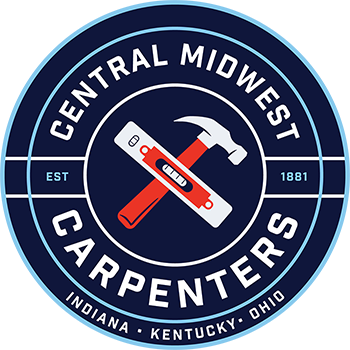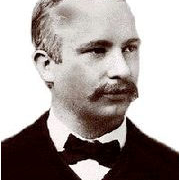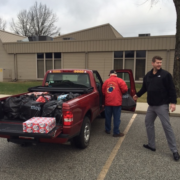Founding A National Union
The Chicago convention was the brainchild of Peter J. McGuire, a 29-year-old carpenter who was to become one of the great labor leaders of the 19th century. A product of the tenements of New York City’s lower East Side, McGuire decided to devote his life to the cause of labor at an early age.
 McGuire recognized that the turmoil in the construction industry made conditions ripe for the organization of carpenters. If the carpenter’s trade was under attack, there was only one appropriate response—protect and defend the trade through the collective action of its members. The delegates who gathered in Chicago acknowledged his leadership as a crucial element of the union’s potential for success. While they could not resolve all the debates over the issue raised at the convention, there was no disagreement over who would fill the one full-time position. McGuire was unanimously elected to the post of General Secretary.
McGuire recognized that the turmoil in the construction industry made conditions ripe for the organization of carpenters. If the carpenter’s trade was under attack, there was only one appropriate response—protect and defend the trade through the collective action of its members. The delegates who gathered in Chicago acknowledged his leadership as a crucial element of the union’s potential for success. While they could not resolve all the debates over the issue raised at the convention, there was no disagreement over who would fill the one full-time position. McGuire was unanimously elected to the post of General Secretary.
The union grew gradually, from a membership of 2,042 in 1881 to 5,789 in 1885. Some cities were well organized while others remained entirely non-union. McGuire worked 18 hours a day to keep the union alive. However, in 1882, both McGuire and the union were penniless. McGuire was forced to borrow $30 from a friend just to print “Carpenter”, the union’s official monthly. McGuire, writing to Gabriel Edmonston, the first UBC General President, for advice and support, vowed to devote his life and wages to keeping the union alive. “I will work at my trade, give up my salary, and kill myself at night to keep things going, if necessary.”
McGuire’s sacrifices eased as the fortunes of the UBC rose with escalating militancy of the American workforce in the 1880s. A general strike initiated and led by the carpenters’ union for the eight-hour work day on May 1, 1886, began what proved to be one of the key political events of 1886, a year that historians refer to as “the great uprising of labor.”
During the spring, McGuire temporarily suspended the regular business of the UBC as he criss-crossed the country speaking to countless audiences about the shorter hours movement. His efforts paid handsome dividends. More than 340,000 workers demonstrated for the reduced working day on May 1. In almost every city, carpenters led striking marchers. As a result, union carpenters won higher wages and/or decreased hours in 53 cities in 1886. Unorganized carpenters flocked to the activist organization as the Brotherhood’s membership swelled to 21,423 by the end of the summer.
The militancy of American workers in 1886 stunned the business world and surprised cautious labor leaders. The hundreds of rallies, walkouts, and strikes demonstrated the appeal of the eight-hour day and prompted the American Federation of Labor to plan a follow-up series of actions for May 1, 1890, under the banner of the nation’s single most effective labor organization. The AFL selected the Carpenters Union because, in the words of President Samuel Gompers, it was the “best disciplined, prepared and determined” force in the labor movement. The UBC lived up to its reputation. As part of a massive national and international effort in 1890, over 23,000 American carpenters in 36 cities won the eight-hour day and 32,000 more gained a nine-hour workday. At the end of the campaign, McGuire was able to describe the 55,000-member UBC as “the largest and most powerful organization, numerically, of any special trade in the whole civilized world.”
A carpenter’s average wage at the time of the union’s birth was $2 a day. Twenty years later it had doubled, and it was as high as $5 in the larger cities. By 1903, union membership had climbed to 167,200. Four years later, eight hours was the standard length of the carpenter’s work day across the country, at a time when ten- and twelve-hour days were still common in many other industries.
Success rarely comes without cost, however. And McGuire’s years of maintaining a grinding schedule took their toll. By the turn of the century, his body was wracked with disease. McGuire resigned at the union’s 1902 convention, looking considerably older than his 50 years. The now-frail leader told the assembled delegates that he could not and would not continue as their leader. “A man wears out like a piece of machinery,” he concluded. The man who founded the Brotherhood and presided over its meteoric growth died four years later at his home in Camden, New Jersey.



 Gov. Pat McCrory of North Carolina signed an
Gov. Pat McCrory of North Carolina signed an 
 In August 1881, 36 carpenters from eleven cities met in a Chicago warehouse to form a national union. Four days of heated discussion produced a constitution, a structure, and a new organization with two thousand members—the Brotherhood of Carpenters and Joiners of America.
In August 1881, 36 carpenters from eleven cities met in a Chicago warehouse to form a national union. Four days of heated discussion produced a constitution, a structure, and a new organization with two thousand members—the Brotherhood of Carpenters and Joiners of America.
 In an ongoing effort to give back to the community, Local 1005 of the Indiana/Kentucky/Ohio Regional Council of Carpenters (IKORCC) collected and donated toys to the U.S. Marine Corps Reserve Toys for Tots program this past holiday season.
In an ongoing effort to give back to the community, Local 1005 of the Indiana/Kentucky/Ohio Regional Council of Carpenters (IKORCC) collected and donated toys to the U.S. Marine Corps Reserve Toys for Tots program this past holiday season.